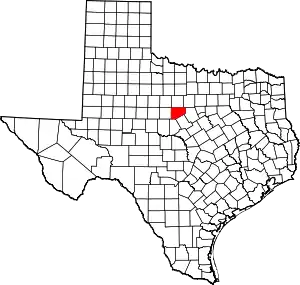Eastland County, Texas
Eastland County is a county located in central West Texas. As of the 2010 census, its population was 18,583.[1] The county seat is Eastland.[2] The county was founded in 1858 and later organized in 1873.[3] It is named for William Mosby Eastland, a soldier during the Texas Revolution and the only officer to die as a result of the "Black Bean executions" of the Mier Expedition.
Eastland County | |
|---|---|
 Trees block the view of the Eastland County Courthouse in Eastland | |
 Location within the U.S. state of Texas | |
 Texas's location within the U.S. | |
| Coordinates: 32°20′N 98°50′W | |
| Country | |
| State | |
| Founded | 1873 |
| Seat | Eastland |
| Largest city | Eastland |
| Area | |
| • Total | 932 sq mi (2,410 km2) |
| • Land | 926 sq mi (2,400 km2) |
| • Water | 5.4 sq mi (14 km2) 0.6%% |
| Population (2010) | |
| • Total | 18,583 |
| • Density | 20/sq mi (8/km2) |
| Time zone | UTC−6 (Central) |
| • Summer (DST) | UTC−5 (CDT) |
| Congressional district | 11th |
| Website | www |



Two Eastland County communities, Cisco and Ranger, have junior colleges.
Geography
According to the U.S. Census Bureau, the county has a total area of 932 square miles (2,410 km2), of which 926 square miles (2,400 km2) are land and 5.4 square miles (14 km2) (0.6%) are covered by water.[4]
Major highways
.svg.png.webp) Interstate 20
Interstate 20 U.S. Highway 183
U.S. Highway 183 State Highway 6
State Highway 6 State Highway 16
State Highway 16 State Highway 36
State Highway 36 State Highway 112
State Highway 112
Adjacent counties
- Stephens County (north)
- Palo Pinto County (northeast)
- Erath County (east)
- Comanche County (southeast)
- Brown County (south)
- Callahan County (west)
- Shackelford County (northwest)
Demographics
| Historical population | |||
|---|---|---|---|
| Census | Pop. | %± | |
| 1860 | 99 | — | |
| 1870 | 88 | −11.1% | |
| 1880 | 4,855 | 5,417.0% | |
| 1890 | 10,373 | 113.7% | |
| 1900 | 17,971 | 73.2% | |
| 1910 | 23,421 | 30.3% | |
| 1920 | 58,505 | 149.8% | |
| 1930 | 34,156 | −41.6% | |
| 1940 | 30,345 | −11.2% | |
| 1950 | 23,942 | −21.1% | |
| 1960 | 19,526 | −18.4% | |
| 1970 | 18,092 | −7.3% | |
| 1980 | 19,480 | 7.7% | |
| 1990 | 18,488 | −5.1% | |
| 2000 | 18,297 | −1.0% | |
| 2010 | 18,583 | 1.6% | |
| 2019 (est.) | 18,360 | [5] | −1.2% |
| U.S. Decennial Census[6] 1850–2010[7] 2010–2014[1] | |||
As of the census[8] of 2000, 18,297 people, 7,321 households, and 5,036 families resided in the county. The population density was 20 people per square mile (8/km2). The 9,547 housing units averaged 10 per square mile (4/km2). The racial makeup of the county was 91.03% White, 2.18% African American, 0.48% Native American, 0.21% Asian, 0.02% Pacific Islander, 4.83% from other races, and 1.25% from two or more races. About 10.80% of the population was Hispanic or Latino of any race.
Of the 7,321 households, 27.70% had children under the age of 18 living with them, 55.40% were married couples living together, 9.50% had a female householder with no husband present, and 31.20% were not families. About 28.6% of all households were made up of individuals, and 16.20% had someone living alone who was 65 years of age or older. The average household size was 2.39 and the average family size was 2.93.
In the county, the population was distributed as 23.20% under the age of 18, 9.80% from 18 to 24, 22.30% from 25 to 44, 23.90% from 45 to 64, and 20.90% who were 65 years of age or older. The median age was 41 years. For every 100 females, there were 94.10 males. For every 100 females age 18 and over, there were 90.60 males.
The median income for a household in the county was $26,832, and for a family was $33,562. Males had a median income of $25,598 versus $17,112 for females. The per capita income for the county was $14,870. About 12.10% of families and 16.80% of the population were below the poverty line, including 23.10% of those under age 18 and 14.80% of those age 65 or over.
Education
Despite its small population, the county is home to two community colleges – Cisco College and Ranger College, located in their respective towns.
Media
Eastland County is part of the Abilene/Sweetwater/Brownwood television viewing area in west-central Texas. Local news media outlets include KRBC-TV, KTXS-TV, KXVA, and KTAB-TV. In the cities of Eastland, Ranger, and Cisco on Suddenlink Communications Cable Television service, residents can view the Dallas/Fort Worth market stations WFAA-TV and KERA-TV.
Eastland County is also served by four local newspapers: the Eastland Telegram, the Rising Star, Ranger Times, and Cisco Press.
Communities
Towns
Unincorporated communities
- Kokomo
- Morton Valley
- Nimrod
- Olden
- Romney
Ghost towns
- Desdemona
- Mangum
Politics
| Year | Republican | Democratic | Third parties |
|---|---|---|---|
| 2016 | 86.3% 6,011 | 11.1% 776 | 2.5% 176 |
| 2012 | 83.8% 5,444 | 14.9% 970 | 1.3% 81 |
| 2008 | 79.4% 5,165 | 19.5% 1,271 | 1.1% 73 |
| 2004 | 76.6% 5,249 | 23.1% 1,582 | 0.4% 26 |
| 2000 | 70.6% 4,531 | 27.7% 1,774 | 1.7% 109 |
| 1996 | 49.6% 3,272 | 39.3% 2,594 | 11.1% 730 |
| 1992 | 38.9% 2,830 | 37.6% 2,738 | 23.5% 1,713 |
| 1988 | 54.8% 3,929 | 44.9% 3,215 | 0.3% 22 |
| 1984 | 65.5% 4,841 | 34.1% 2,522 | 0.4% 26 |
| 1980 | 50.1% 3,442 | 48.7% 3,346 | 1.3% 89 |
| 1976 | 35.0% 2,340 | 64.5% 4,320 | 0.5% 35 |
| 1972 | 71.5% 4,106 | 28.4% 1,630 | 0.1% 7 |
| 1968 | 38.6% 2,453 | 45.4% 2,884 | 16.0% 1,013 |
| 1964 | 30.4% 2,049 | 69.5% 4,692 | 0.2% 11 |
| 1960 | 52.1% 3,359 | 47.4% 3,058 | 0.5% 32 |
| 1956 | 58.6% 3,580 | 41.1% 2,512 | 0.3% 16 |
| 1952 | 57.2% 4,518 | 42.6% 3,370 | 0.2% 18 |
| 1948 | 17.7% 1,177 | 76.8% 5,121 | 5.5% 367 |
| 1944 | 10.6% 643 | 75.9% 4,607 | 13.5% 822 |
| 1940 | 15.4% 1,063 | 84.5% 5,818 | 0.1% 6 |
| 1936 | 13.4% 724 | 86.0% 4,659 | 0.7% 35 |
| 1932 | 10.8% 598 | 89.2% 4,958 | |
| 1928 | 56.4% 3,233 | 43.6% 2,501 | |
| 1924 | 17.1% 972 | 80.0% 4,548 | 2.9% 162 |
| 1920 | 23.1% 941 | 72.3% 2,942 | 4.6% 186 |
| 1916 | 7.5% 146 | 76.6% 1,486 | 15.8% 307 |
| 1912 | 4.0% 66 | 90.5% 1,498 | 5.5% 91 |
See also
References
- "State & County QuickFacts". United States Census Bureau. Archived from the original on July 14, 2011. Retrieved December 10, 2013.
- "Find a County". National Association of Counties. Archived from the original on 2012-07-12. Retrieved 2011-06-07.
- "Texas: Individual County Chronologies". Texas Atlas of Historical County Boundaries. The Newberry Library. 2008. Retrieved May 23, 2015.
- "2010 Census Gazetteer Files". United States Census Bureau. August 22, 2012. Retrieved April 26, 2015.
- "Population and Housing Unit Estimates". United States Census Bureau. May 24, 2020. Retrieved May 27, 2020.
- "U.S. Decennial Census". United States Census Bureau. Retrieved April 26, 2015.
- "Texas Almanac: Population History of Counties from 1850–2010" (PDF). Texas Almanac. Retrieved April 26, 2015.
- "U.S. Census website". United States Census Bureau. Retrieved 2011-05-14.
- Leip, David. "Dave Leip's Atlas of U.S. Presidential Elections". uselectionatlas.org. Retrieved 2018-07-22.
